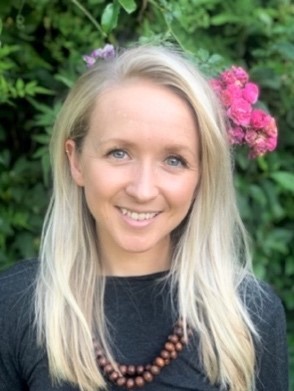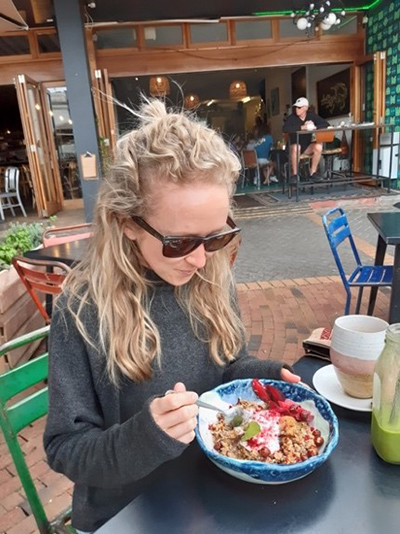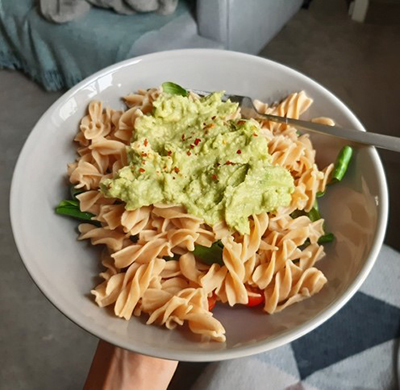Rosie is an award-winning registered dietitian, who has coeliac disease, and is also vegan. Having come from a career in zoology, Rosie now works in various NHS roles including oncology and occupational health, as well as working as a freelance plant-based dietitian.
Here we ask Rosie about her unique experience as a dietitian following a strictly gluten-free and vegan diet.
 When were you diagnosed, and what have been the main challenges and silver linings of living with coeliac disease?
When were you diagnosed, and what have been the main challenges and silver linings of living with coeliac disease?
I was diagnosed with coeliac disease (CD) when I was 9 months old after failing to thrive when I was weaning. Such a young diagnosis is generally uncommon as many people appear to develop the condition later in life.
Living with CD was most challenging through my school years. I don’t remember anyone ever being mean to me, and my teachers were generally very understanding, but as children and teenagers, fitting in is usually a top priority. I was the girl with the special diet, the one with the different biscuits at break time, and the one who had to bring her own food to parties. It’s easy to forget that very few people knew what ‘coeliac’ or ‘gluten’ was through the 1990s.
The silver lining has definitely been my heightened awareness of the role that food plays in our health and wellbeing. Although I came to dietetics as a second career, I have always been fascinated by food and its impact on our physical and psychological wellness. Having experienced CD first hand, I also have an insight into the experience of those living with the condition which has been beneficial to my professional practice and being able to support others. I also don’t mind being different now!
How do you manage living with coeliac disease and following a vegan lifestyle in tandem?
My vegan lifestyle began in 2013, by which time I was in my mid-20s. Although it sounds like a very restrictive diet, the foods I ate actually diversified during this time.
 The main foods that CD rules out are wheat, rye and barley-based foods including starchy carbohydrates such as bread, pasta and cereals. Veganism on the other hand excludes animal products, including meat, eggs, fish and dairy. Although it might seem that fruits and vegetables are the only things left, this is not the case! Replacements for excluded foods are varied and abundant once you know where to find and how to use them. Following a vegan diet with CD is very possible once you know how. Instead of wheat pasta and breads, my cupboards are filled with brown rice pasta and buckwheat pasta, quinoa and egg-free gluten-free bread. Instead of cow’s milk, I use a diverse range of alternative milks including soya, almond, rice, even hemp! For higher protein foods, instead of eggs or chicken, I have tofu, tempeh, beans, pulses, nut and seeds.
The main foods that CD rules out are wheat, rye and barley-based foods including starchy carbohydrates such as bread, pasta and cereals. Veganism on the other hand excludes animal products, including meat, eggs, fish and dairy. Although it might seem that fruits and vegetables are the only things left, this is not the case! Replacements for excluded foods are varied and abundant once you know where to find and how to use them. Following a vegan diet with CD is very possible once you know how. Instead of wheat pasta and breads, my cupboards are filled with brown rice pasta and buckwheat pasta, quinoa and egg-free gluten-free bread. Instead of cow’s milk, I use a diverse range of alternative milks including soya, almond, rice, even hemp! For higher protein foods, instead of eggs or chicken, I have tofu, tempeh, beans, pulses, nut and seeds.
When I became vegan I discovered a new love of cooking and experimenting. I really love eating this way and I certainly feel it does wonders for my health and wellbeing.
As a dietitian and a person living with coeliac disease, what would you say to someone concerned that they might have this condition?
There are many signs that someone may be living with CD. Potential symptoms are varied and can include (amongst others), unintentional weight loss, stomach pain, bowel issues such as bloating, wind, diarrhoea and constipation, anaemia (low blood iron levels) or osteoporosis (weak bones). If you have CD in your family, you are also more at risk of developing the condition.
If you are concerned or have unexplained symptoms, I would strongly recommend speaking to your family doctor in the first instance; they will chat through your symptoms and be able to offer you a simple blood test. Bear in mind that you must keep gluten in your diet when being tested for the results to be reliable, as it detects antibodies (immune cells) that are produced by people with CD when gluten is consumed.
What changes have you noticed in recent years in terms of awareness around special diets?
Awareness around special diets has increased substantially over the past 5-10 years, with increased accessibility of ‘free from’ foods, and more acceptability of special dietary requirements at restaurants and events. This is really valuable for those living with a dietary-controlled condition.
Vegan and gluten-free companies have amazed me with the range of products they have come up with over the past few years, some of them I could never have dreamed of as a child. This is a sign of increased awareness and accessibility, and may help those who are newly diagnosed adopt a gluten-free diet. However, it is important to remember that too much reliance on these newly available highly processed products such as cakes, biscuits, and ready meals does not promote our health and wellbeing, despite being suitable for the diet.
I think it is important to continue to spread the awareness, but ensuring the reliable information being available is key. There are countless individuals sharing nutrition information in person and online, and many will claim to be experts, despite not having a nutritional science background. This means that having organisations and professionals that we can rely on, like Coeliac UK and The Vegan Society, are increasingly vital to provide trusted information that is rooted in science.
In my own experience, with more people following a gluten-free diet out of personal choice, I have found that some food outlets and waiting staff can be complacent about the importance of a gluten-free diet for those with CD. For example, if you follow a gluten-free diet out of choice, you might be fine with the restaurant cutting wheat-bread and gluten-free bread with the same knife, but someone with CD would absolutely not be! When I eat at a restaurant I always state that I have CD and ensure the message is relayed to the chef preparing my meal.
How has COVID-19 affected your daily life in terms of food shopping and meal preparation?
I have been trying to limit my travel to the supermarket, so I have been buying more long-life foods such as canned beans and pulses, long life plant milks, dried pasta and canned tomatoes and vegetables. Canned and frozen foods are generally just as (sometimes more) nutritious as the fresh alternatives and will count in your fruit and vegetable intake. I haven’t experienced it myself, but I know some of my patients and others with CD have struggled to get hold of gluten-free items such as pasta and bread, which is obviously worrying when the more common alternatives are not an option.
Do you have any tips for those who may be encountering the same issues?
I would recommend keeping your diet varied; if you can’t get hold of your normal vegetables or favourite beans, try new ones. By having recipes you can make from naturally gluten-free foods, for example potatoes, brown rice, vegetables, tofu and beans, you will also reduce your reliance on the more expensive specialist products in the ‘free from’ aisle. Incorporating more whole foods like these will be better for your health as well as reduce the likelihood of ‘hidden’ gluten or animal products in the ingredients list.
Make sure you are getting a good balance of food groups including plenty of fruits and vegetables, wholegrain starchy carbohydrates, plant-based proteins and fortified alternative dairy products. If you are not taking supplements, I recommend vitamin B12, iodine, and vitamin D (particularly if you are spending less time outside during the COVID19 lockdown). The Vegan Society website’s nutrition pages are a great source of information, and their VEG 1 supplement is an affordable way to get the recommended vitamins and minerals.
Some of our Thriving recipes are easily adaptable to a gluten-free diet; which takes your fancy?
I love the look of the satay tofu and spring onion rice, nut butters are a weakness of mine so satay always goes down well. The lentil and mushroom pate looks delicious and would go great on a hot piece of seeded gluten-free toast, or a rice cake. Although I don’t think you can beat a good old lentil Shephard’s pie for home comfort; it’s one of my Mum’s specialities.
 What are some of your favourite meals to prepare?
What are some of your favourite meals to prepare?
On working days I’ll often rustle up a quick pasta dish. I use brown rice or buckwheat pasta, mash up some ripe avocado with lemon juice, garlic, salt and black pepper and add any veggies I have in my kitchen, for example kale, tomatoes, mushrooms or canned beans. I sometimes top it with some nutritional yeast for a cheesy flavour and a dose of vitamin B12. Stir-frying rice noodles, tofu and mixed vegetables is another go-to. I make a stir-fry sauce using ginger, garlic, tamari, lime and sometimes add in peanut butter, tahini or sesame oil for a richer dish. With a bit more time I love to make red lentil and sweet potato dahls, or a Bolognese using kidney beans, flavoured with miso and red wine.
You can follow Rosie’s food adventures on her Instagram @plantdietitianrosie
The views expressed by our bloggers are not necessarily the views of The Vegan Society.

